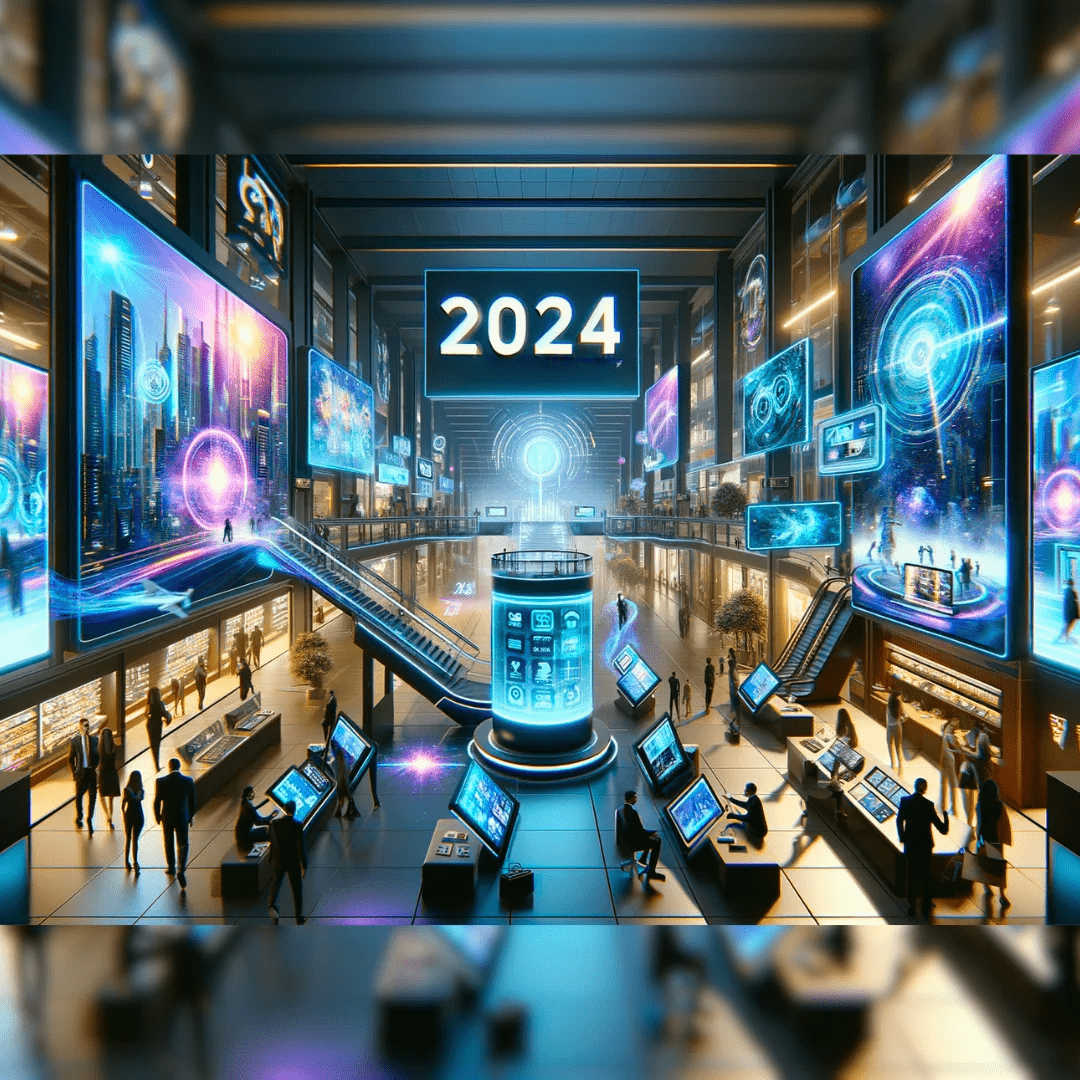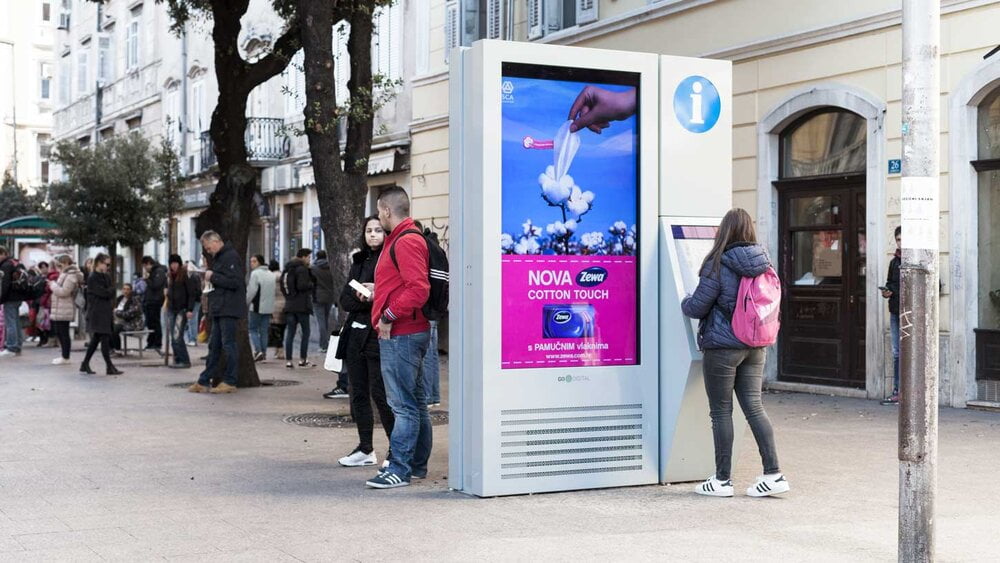With the advent of the digital era, businesses are constantly evolving to outperform the competition in the growing marketplace. Smart digital signage solutions that are smart, provide real-time, dynamic data, and so on are replacing traditional signage — static posters and billboards.

Nowadays, smart digital signage systems are used in retail stores, corporate offices, restaurants and any public spaces to attract the attention of audiences, boost customer engagement, facilitate communication, and provide a solid foundation for serious development. The combination of AI, cloud, and IoT has completely shaken smart digital signage up, and it is changing how brands relate to users by offering personalized, engaging, and visually appealing experiences.
1. The Rise of Smart Digital Signage in the Modern Business Landscape
However, in recent years, this digital signage industry has taken an enormous shift from being a mere simple static display to a smart one with sophisticated features: AI-powered digital signage systems. These are some reasons for this transition:
- The Shift from Traditional Signage – In most cases, Static signs and printed ads are not adequate for current marketing and customer engagement requirements.
- Real-time and Personalized Content Demand – The customer expects the content to be personalized based on their interests, preferences, and behavior.
- AI & Cloud digital transformation – Data of customers is analyzed by using an AI and signage content is optimized, using a cloud platform and management so that digital signs can be updated easily at several locations without any hitch.
However, as more and more companies invest in smart digital signage solutions to get these results, they continue reaping these benefits.
2. Understanding Smart Digital Signage: What Sets It Apart?
Digital signage is smart if it can do anything other than provide static images or loop videos and can adapt for customer behavior and react real time data at the same time. But what qualifies a digital signage system as being a smart digital signage system?
AI & Machine Learning Integration – Smart digital signage knows what the customer’s age is, gender, and browsing behavior, and adapts to display content appropriate to those numbers.
Real Time Content Management from Cloud – Allows the business to update screens of multiple locations remotely, from any place in the world.
Cloud-Based Content Management – Content is automated by connecting to POS systems, mobile apps, security cameras, and smart sensors, etc., to integrate into IoT & systems.
IoT & System Integration – Supports touchscreen display, gesture control, and QR code scanning for interactive user experience.
Analytics & Data Tracking – Real time Customer Engagement, Dwell time, Ad performance
Traditional vs. Smart Digital Signage: The Key Differences
Feature | Traditional Digital Signage | Smart Digital Signage |
Content Updates | Manual requires frequent replacements | Remote, real-time cloud updates |
Personalization | Generic, static messages | AI-driven, personalized content |
Interactivity | No interaction with users | Touchscreens, gesture control, voice commands |
Data Insights | No analytics available | Customer tracking & engagement metrics |
| Scalability | Limited to single locations | Multi-location, cloud-based control |
Unlike other digital signage which can be either on for undetermined amount of time or need an employee to update the information on it, smart signage interacts with the environment, adapts itself dynamically according to the user’s behavior and business needs.

3. How does Smart Digital Signage Work? Breaking Down the System:
There are three main components of a smart digital signage system.
Hardware Components
Smart Digital Signage Display Screens – High-Definition LED, LCD, or OLED screens.
Media Players & Sensors – Process and display AI-driven content while detecting customer behavior.
Software Components
Smart Digital Signage Software (CMS) – A cloud-based solution that updates and updates the content, set the schedules and use AI personalization.
AI-Powered Analytics – Tracks customer engagement, analytics and adjusts the content to it, thereby analyzing the visitor demographics.
Connectivity & Integration
Cloud Based Access – Allows businesses to update multiple screens remotely live.
IoT & POS Integration – Option for Integration with POS/IoT (sensor data, surveillance camera data, customer management data and can be used to automate menu adaptation).
For instance, a retail store can employ a digital signage system that views the age and gender of their customers and then shows promotions intended to the analysis. At the same time, a restaurant can automatically change menus throughout the day between breakfast, lunch, and dinner menus.
4. Game-Changing Features of Smart Digital Signage
One of the distinctive features about Smart digital signage is its innovative features that increase customer engagement and improvement operations.
AI & Machine Learning Capabilities
Displays Real-Time Content Personalization, ads and promotions that the customer would be interested in based on the demographic.
Demand and inventory-based pricing that is also backed by seasonal trends.
Real-Time Content Updates & Automation
Decide based on time of day, weather or customer flow.
Quickly update prices, promotions and event schedules across multiple locations.
Interactive Touchscreen & Gesture Control
Salesmen using touch enabled displays can browse through product catalogs, place orders and navigate through store layout plans.
These devices facilitate a touch free experience in health-conscious environment using motion sensors & gesture recognition.
 Cloud-Based & Remote Access
Cloud-Based & Remote Access
Control multiple screens located in different store locations remotely.
Sync digital signage with online promotions & social media campaigns.
IoT & Smart Device Integration
Smart signage systems sync with POS, inventory management, and mobile apps.
Cameras that are powered by AI track how engaged customers are and what amount of time they spend to optimize messaging.
For example, there is smart signage with facial recognition so it can recommend outfits based on past purchases in a clothing store and in a QSR (Quick Service Restaurant), it can deploy AI-powered self-order kiosk for better customer experience.
5. Types of Smart Digital Signage and Their Applications
There are many formats of smart digital signage solution depending on the business needs.
Indoor Smart Digital Signage
Used in retail stores, corporate offices and restaurants.
It shows real time promotions, event schedule and customer engagement content.
Outdoor Smart Digital Signage
Weather-resistant displays for billboards, public spaces, and transportation hubs.
Advertised, used to give an update on the event and as a live news feed.
Interactive Digital Signage
Provides self-service ordering, product browsing and way finding.
Ideal for shopping malls, airports, and smart retail stores.
AI-Powered Digital Signage
Sends personalized ads according to the customer’s behavior and their preferences.
It is commonly used in luxury retail, hotels, as well as in personalized shopping experiences.
Cloud-Based Smart Signage
Enables remote updating of the content and centralized management.
Must do for franchises, corporate chains and companies running multiple stores.
Depending on the needs of businesses, there are so many smart digital signage solutions to choose from, from an interactive retail display, a self-ordering kiosk in restaurants, to an AI powered personal shopping assistant.
6. Industries Leveraging Smart Digital Signage for Growth
One of the exciting applications of smart digital signage has proved to be the changing of how various industries communicate, engage customers, and even run operations. Here is the effect of this new technology in different sectors:
Retail & Shopping Malls
The Dynamic Digital Price Tags part allows the pricing to change in real time according to the demand, promotions, or inventory levels.
Interactive Product Catalogs – Customers can view in detail product information, about, demos, and other options.
Personalized Promotion – With AI-driven signage, it suggests the products as per the shopping behavior and customer demographics.
Quick-Service Restaurants (QSRs) & Cafés
Digital Menu Boards change menu items, pricing, and promotions instantly across many locations.
Self-Ordering Kiosks – Speeds the service process and enhances order accuracy with touchscreen ordering.
Dayparting Menus – This makes it easier for your user to choose between the breakfast menu, lunch menu, and dinner menu at different times of the day.
Healthcare & Hospitals
Real-Time Appointment Status – Display real-time updates on the patient’s appointment – Reduce patient wait time.
Doctor & Facility Schedules – Patients can glance at doctor and service availability.
Emergency Alerts & Public Health Updates – Instantly broadcast critical health information or safety instructions.
Corporate Offices
Internal Communication – Display company news, HR updates, and performance dashboards.
They can use digital screens to check if rooms are available and reserve them as meeting spaces.
Corporate Branding & Employee Recognition – Reinforce company culture with engaging visuals.
Education & Universities
Campus Notifications – Send schedules for events, announcements as well as emergency alerts.
Interactive Learning Tools – Interactive content on the touch screen display to engage the student’s young brains.
Wayfinding Solutions – Provide students and visitors with large campuses interactive maps so they have ease of wayfinding.
Airports & Transportation Hubs
Real-Time Flight & Transit Schedules – Reduce passenger confusion with up-to-the-minute travel information.
Navigation & Wayfinding – Interact with travelers to easily guide them to the gates, terminals, and baggage claims with screens in the stations.
Advertising & Retail Promotion – This revenue is generated through promotions, travel deals, and duty-free.
From smart digital signage solutions, businesses of different industries are improving efficiency and lowering operational costs while providing engaging and real-time experiences to their customers and employees.
7. Benefits of Smart Digital Signage for Businesses
There are plenty of advantages for businesses of all sizes to implement a smart digital signage system. Here are some reasons why companies are swapping to CRM:
Increased Customer Engagement
- High-quality visuals, animations, and interactivity help in grabbing customer attention and enhancing their engagement.
- Content can be personalized toward the customer’s liking and preference with the help of AI driven personalized.
Cost-Effective Advertising
- Does away with printed materials, hence cutting down on printing and distribution costs.
- Enables businesses to keep promotions up to date in seconds and shortens the waste and inefficiency cycle.
Enhanced Brand Consistency
- It guarantees uniform messaging across different locations that will reinforce brand identity and marketing strategies.
- It enables franchise businesses to keep the promotional content of the stores consistent.
Real-Time Content Updates
- Does not require any effort to adjust menus, pricing, promotions, and event schedules.
- Content changes are powered by AI automation and are triggered when it is time of day, in case of bad weather, or if levels of inventory change.
AI-Driven Insights
- Helps to track customer foot traffic, dwell time, and engagement rates.
- Offers real-time analytics to boost advertising strategies and business operations.
Today, smart digital signage plays an important role in boosting sales and improving overall customer experience for small businesses and large global enterprises.
8. How to Choose the Best Smart Digital Signage System
The correct choice of smart digital signage software and its hardware will also amplify your investment. Here’s what to consider:
Assess Business Needs
- Decide between indoor and outdoor signage.
Specify the basic goals of the chat: customer engagement, real-time updates, automation, or brand awareness.
Compare Smart Digital Signage Software
- Cloud-based vs. Cloud-based can be updated remotely, whereas on-premise gives more control.
Choose a system that stays with business as it grows.
- AI Capabilities – Look for personalization features and predictive analytics.
 Evaluating Display Quality
Evaluating Display Quality
The visuals will be seen either on high-resolution LED, LCD, or OLED screens.
- Outdoor displays need to be weatherproofed; anti-glare coated and have high brightness levels.
Check for Smart Integrations
- Compatible with POS systems, CRM platforms, and mobile apps.
- Seek IoT-enabled signage that can pair with a facility’s inventory management or customer tracking system.
Look for AI-Powered Features
- Recognize the faces and demographics of Prospective clients.
- Real time analytics and engagement tracking to measure performance of the game.
A well-chosen digital signage system improves customer interaction, improves operational efficiency, and increases business growth.
9. Future Trends in Smart Digital Signage
Over time, technology is changing, and smart digital signage is becoming more and more immersive and AI powered. In general, significant future trends are outlined below.
AI-Powered Personalization
- Smart signage will analyze real-time customer demographics to come up with hyper-personal content.
- It can adjust its supply price dynamically based on any fluctuations that are based on demand, weather, and shopping habits.
Augmented Reality (AR)
- AR will be integrated by retailers so that customers can preview clothing, makeup, or furniture before buying.
- AR will enable shoppers to navigate malls and large stores using AR-enabled wayfinding.
Voice-Controlled & Gesture-Based Signage
- It will involve customers interacting with signage via voice command and hand gestures instead of touchscreens.
Integration with Smart Wearables & Mobile Apps
- Bright signage will interact with wearables such as smartwatches to recommend items to the wearer.
- The digital menu boards will be synchronized with the contactless dining mobile ordering apps.
Energy-Efficient & Eco-Friendly Digital Signage
- Solar powered digital billboards and low energy LED screens will be more sustainable.
- Recyclable materials will be used in making of the signage which will cut down the carbon footprint of businesses.
The future has already begun with AI, AR, and IoT innovations, which are transforming the future of smart digital signage to remain relevant.
10. Elevate Your Business with Nento’s Smart Digital Signage Solutions
The Nento smart digital signage is one that will revolutionize and transform your business communication.
✅ Seamless cloud-based content management.
✅ Real-time promotions & AI-powered analytics.
✅ Integration with POS, CRM, and IoT devices.
🚀 Upgrade your signage strategy today with Nento!
Frequently Asked Questions (FAQs)
What is the difference between smart digital signage and traditional signage?
✅ Smart signage is dynamic and has capabilities of AI, real-time updates, and futuristic cloud-based technology, while traditional signage is static and requires physical manual updates.
Can smart digital signage integrate with POS and CRM systems?
✅ Yes! Seamless integration of the POS, CRM, and analytics tools is supported by most smart digital signage systems.
Is smart digital signage expensive?
✅ Cost is dependent on the device’s features, display size, and AI capabilities, but there are long-term savings versus the initial investment.
What industries benefit the most from digital signage?
✅ Smart signage is used in retail, restaurants, healthcare, corporate offices, and transportation hubs to increase efficiency.
Can I control my digital signage remotely?
✅ Yes! Digital signage software in the cloud brings remote access and content updates anywhere.


 Cloud-Based & Remote Access
Cloud-Based & Remote Access
 Evaluating Display Quality
Evaluating Display Quality


